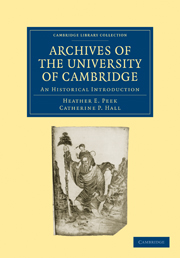Book contents
- Frontmatter
- Contents
- List of Plates
- Preface
- PART I
- PART II
- 4 The University and Colleges as Privileged Corporations
- 5 Records of University Administration
- 6 Records of Matriculation and Degrees
- 7 Financial Records of the University
- 8 Endowments of the University
- 9 University Officers and their Records
- 10 Records of the University Courts
- 11 Records of University Jurisdiction in the Town of Cambridge
- 12 The Relations between the Crown and the University
- 13 Other University Institutions and their Records
- APPENDICES
- Index
- Index to Muniments of Title in Appendix B
- Plate section
6 - Records of Matriculation and Degrees
Published online by Cambridge University Press: 07 September 2010
- Frontmatter
- Contents
- List of Plates
- Preface
- PART I
- PART II
- 4 The University and Colleges as Privileged Corporations
- 5 Records of University Administration
- 6 Records of Matriculation and Degrees
- 7 Financial Records of the University
- 8 Endowments of the University
- 9 University Officers and their Records
- 10 Records of the University Courts
- 11 Records of University Jurisdiction in the Town of Cambridge
- 12 The Relations between the Crown and the University
- 13 Other University Institutions and their Records
- APPENDICES
- Index
- Index to Muniments of Title in Appendix B
- Plate section
Summary
Two groups in the archives relate to matriculations. First, there are the Praelectors’ Lists, submitted to the registrary by the individual colleges, which are very rough and usually undated. These survive from about 1589. Secondly, the registrary or his clerk compiled from these lists the Matriculation Registers, which run from 1544, when matriculation was instituted by statute, to the present day. From 1724 an undergraduate signed his own name in the registers. Matriculation was the occasion of his taking the oath of fidelity to his Alma Mater, a ceremony, says Venn, ‘presumably of very ancient origin, although there are no extant records of the ceremony earlier than this date’ (that is, 1544). Students under the age of fourteen did not have to take the oath. They are distinguished by the word ‘impubes’. The Matriculation Registers are the only official record of membership of the university, but unfortunately present some inaccuracies, and there are also several omissions. Many names of students who undoubtedly came into residence are omitted altogether. For the period 1590–1601, no matriculations have been recorded at all, owing to the negligence of the then registrary.
The principal record of degrees conferred is in the Graces listed in the Grace Books. From 1498/9 the Graces for each degree are normally supplemented in the Grace Books by the annual ‘Ordo Senioritatis’ which was later replaced by the printed Tripos Lists. From 1491/2 to 1497/8, miscellaneous lists of the ‘Ordo’ survive. It is impossible to say on what grounds the arrangement was originally made; in many cases priority was certainly granted to social position: the fellow-commoner, or young man of family, often stands first.
- Type
- Chapter
- Information
- Archives of the University of CambridgeAn Historical Introduction, pp. 30 - 34Publisher: Cambridge University PressPrint publication year: 1963First published in: 1962



